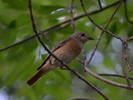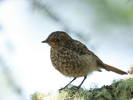search
classification
|
basic information
|
Eurasian Redstart
Phoenicurus phoenicurus (Linnaeus, 1758)

|
 male
|
|
|
2014-06-09
Shushensky rayon. Krasnoyarsky Kray. |
© Sergey Chumakov
|
|
Description
The Eurasian Redstart is some less than sparrow. The male in summer has a slate-grey head and upperparts, except the rump and tail, which, like the flanks, underwing coverts and axillaries are orange-chestnut. The forehead and supercilium are white; the sides of the face and throat are black. The wings and the two central tail feathers are brown. The orange on the flanks shades to almost white on the belly. The bill and legs are black. In autumn, broad margins obscure the colours of the male, giving a washed-out appearance. The female is browner, with paler underparts; she lacks the black and slate, and her throat is whitish. The female is distinguished from same coloring and sizing birds by the red tail. Unlike the tail of Bluethroat it has not dark terminal band. The juveniles in first plumage as well as many other Turidae birds have mottled plumage but they yet have species character as the red tail, rump and uppertail. In the mid-end summer the first plumage is changed to first winter plumage similar to the female. Unlike female juveniles have light strips formed by buff tips of the coverts. Young males are distinguished from females by the darker throat and the more orange breast. It often weak-willed twitches by the slightly lowered tail. Flitting Redstarts open the tail and it as though flashes the red. Weight 11-20 grams, length 13-17, wing 7,5-8,6, wingspan 22-27 cm.
Biology
The Eurasian Redstart is common, in places rare breeding migrant. It inhabits deciduous, mixed and coniferous forests, forests in forest-steppe, groves on plains, and in mountains on 1800 m in Altai and 1900-2700 m in Zailiyskiy Alatau. On migration it visits saxaul forests, reed-beds, forest-belts, bush thickets and gardens. In southern areas it appears rare in March, most in early April; migration finishes in the end of May or in early June. In the highlands first the birds recorded only in early - mid May. It breeds in separate pairs at 30-50, or 100-300 m from each other. In the nature the density of the breeding most depends from the availability of the holes in the forest. The Male occupies the territory only on availability the place to nest. The nest is built by female (male sometimes escort her) in the tree holes, in the stamps, under the bark detached from trunk, under the house roofs, in the nest-boxes at 0.5-6 m above the ground; rare on the ground under the stone or in the cavity between the stones. It is constructed for 3-9 days from the dry grass, bast and moss and is lined with hair and feather. Clutches of 4-8 eggs is found in early May – early July. Only female incubates for 11-14 days. Both parents feed juveniles fledged at 13-15 days old, in mid-June - end July. On plains, in Markakol lake and in Zailiyskiy Alatau two broods reared per year. It is typical insectivorous bird but in autumn it gladly eats the berries. Autumn migration starts on second half of August, majority of the birds leave the breeding areas in the end of September, latest migrants recorded in the end of November.
References
















